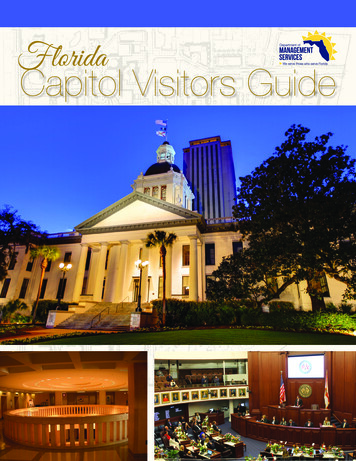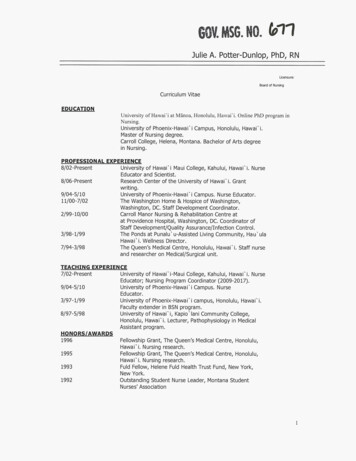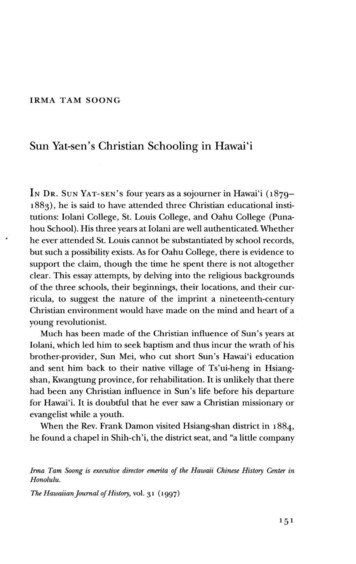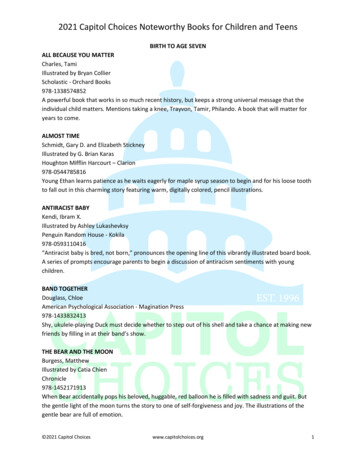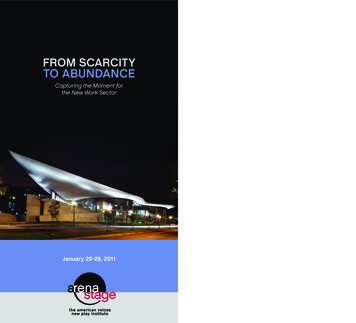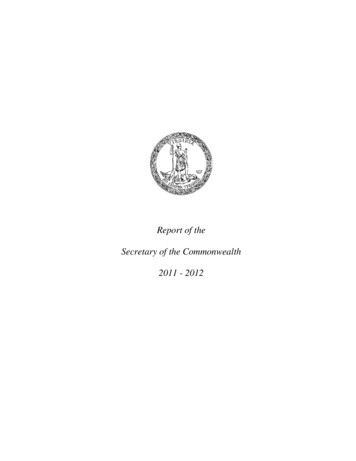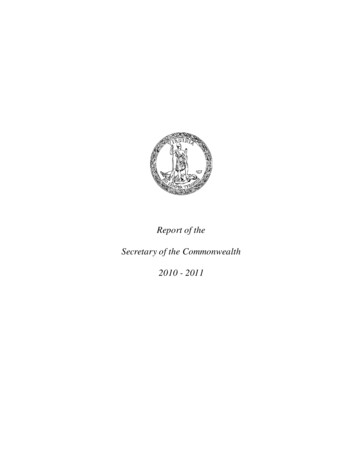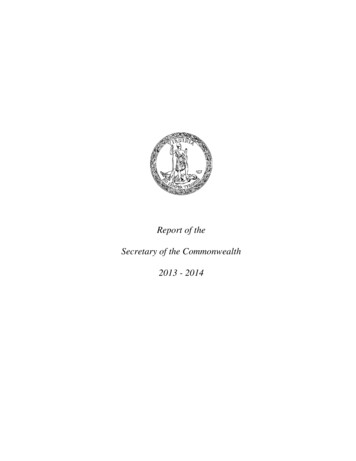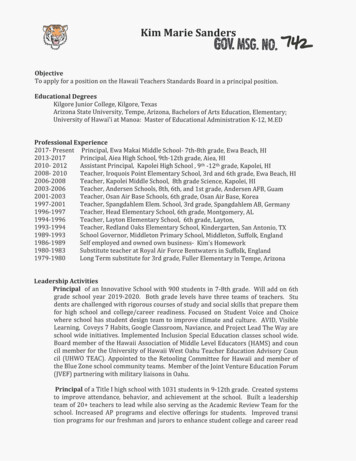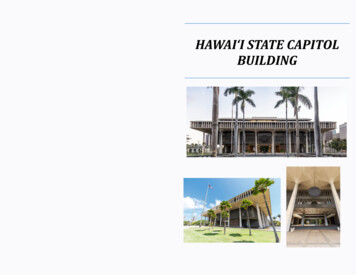
Transcription
HAWAI‘I STATE CAPITOLBUILDING
Hawai‘i State Capitol
Welcome to theHawai‘i State CapitolHonolulu, Hawai‘i
Territorial Governors of Hawai‘iWelcome to Hawai‘i’s State Capitol BuildingWhen Hawai‘i was still a territory of the United States, thegovernors were appointed by the President of the UnitedStates. Governors have been elected since 1959 when webecame the 50th state of the Union. 1900 to 1903 – Sanford B. Dole 1903 to 1907 – George R. Carter 1907 to 1913 – Walter F. Frear 1913 to 1918 – Lucius E. Pinkham 1918 to 1921 – Charles J. McCarthyHawai‘i’s Capitol Building was designed by the architectural firm of JohnCarl Warnecke and Associates of San Francisco, along with the local firm ofBelt, Lemmon and Lo, now known as Architects Hawai‘i. 1921 to 1929 – Wallace R. FarringtonGroundbreaking ceremonies were held on November 11, 1965 anddedicated on March 15, 1969 by Governor John A. Burns. 1929 to 1934 – Lawrence M. JuddThe building and the surrounding grounds were designed to be uniquefrom the other 49 state Capitol buildings, which traditionally areFederalist, Georgian, or Classical Revival in design. 1934 to 1942 – Joseph B. Poindexter 1942 to 1951 – Ingram M. Stainback 1951 to 1953 – Oren E. Long 1953 to 1957 – Samuel Wilder King 1957 to 1959 – William F. Quinn (Last appointedTerritorial Governor and the first Governor to be elected tothe State of Hawai‘i)Mahalo, for visiting Hawai‘i’s State Capitol Building. We hope you willfind your visit with us a memorable one.The distinct openness of the central court area incorporates the elementsof nature and reflects the open character of the Hawaiian society.As you stroll through the grounds you will notice the structure’s volcanicshape, a symbol of the islands’ birth. Forty columns rising 60 feet highsurround the building like the royal palm trees, which are in abundance onevery island. If you look to the upper balcony, you will notice a repeatingpattern of eight columns throughout the Capitol, representing the eightmajor islands in the Hawaiian chain.Surrounding the building are reflecting pools that symbolize the PacificOcean from which the islands emerged.
Symbols of Hawai‘iThe Hawai‘i State FlagWhite, Red, and Blue. Eight stripesrepresenting each of the majorislands. The field closely resemblesthe Union Jack of Great Britain fromwhich the original flag was designed.State FishThe Humuhumunukunukuapua‘a is arectangular triggerfish meaning “fishwith a snout like a pig”. It is brown,black, yellow and blue and can gruntlike a pig when cornered.State BirdThe Ne ne , or Hawaiian Goose, is a land birdadapting itself to life in lava surroundings bytransforming webbed feet to claw-like feet andmodified its wing structure for shorter flights.The ne ne is on the Endangered Species list and isprotected by law.State FlowerMa‘o hau hele (yellow hibiscus brackenridgei)was picked by the Hawai‘i State Legislatureas the State flower on June 6, 1988 .State TreeThe kukui (Aleurite Moluccana),better known as the candlenuttree, is a plant speciesintroduced from Polynesia. Thenuts of this tree provided theHawaiians with light, oil,relishes, and medicine.State SealDisplayed over both entrances of theCapitol is our state seal cast in bronze. Itfeatures the heraldic shield with the sunrising at the top symbolizing thedawning of a new era in Hawai‘i. Thetwo figures represented on the seal areKing Kamehameha the Great and theGoddess of Liberty, a symbol of theUnited States, holding the Hawaiian flag.Pictured below the shield is the phoenix, symbolizing the rebirth ofHawai‘i from a Kingdom, to a Republic, to a Territory of the UnitedStates, and then the 50th state of the Union. The eight kalo, or taro,leaves represent the eight major islands of the Hawaiian chain. Thebanana leaves represent fruitfulness, and the maidenhair fernrepresent the lush greenness found in Hawai‘i. Written at the bottom isour state motto: “Ua mau ke ea o ka ‘aina i ka pono” (The life of theland is perpetuated in righteousness).“Aquarius”Designed by local artist Tadashi Sato andlocated at the center of the Capitol under opensky, this 36-foot circular mosaic representsthe changing colors of the Pacific Ocean thatsurrounds our island state. This piece contains600,000 Italian tiles, all in various shades ofblue, except one red tile which isrepresentative of the artist’s signature. Canyou find it?Originally installed at the Capitol in 1969, the mosaic has since beenthrough two renovations. The first in 1988 at a cost of 200,000. Thesecond was an extensive reconstruction of the art piece due to severedamage from exposure to the elements. This was completed in 2009 at acost of 1.4 million.Tadashi Sato was an artist of international stature whose work has hungin places such a New York’s Museum of Modern Art, the GuggenheimWhitney, and the Willard Gallery. The Aquarius is still arguably his mostfamous work of art.
The Liberty BellIn 1950, the U.S. Department ofTreasury had 55 full-sized replicas ofthe Liberty Bell cast. They were giftedto all the states, territories, and theDistrict of Colombia to be displayedand rung on patriotic occasions.Hawai‘i was gifted with bell no. 6 and itis located on the front lawn of the Capitol Building.Korean and Vietnam War MemorialDesigned by the architectural firm of Hughes & Hughes ofHonolulu and dedicated in1994, the wall is a memorialto those patriots fromHawai‘i who gave their livesfor freedom.Saint Damien “Father Damien Statue”Father Joseph Damien de Veuster, also known as the “Martyr ofMoloka‘i” was known for his work in the settlement of Kalaupapa, onthe island of Moloka‘i, where he tended to the physical and spiritualneeds of people with leprosy (Hansen’s disease). During FatherDamien’s service at the settlement, six chapels, a boys’ home and latera girls’ home where built. He assisted in bandaging wounds, digginggraves and the construction of coffins, in addition to hearing confessions and saying Mass every morning.He lived and worked among them for 16 years before contracting thedisease. He died peacefully on April 15, 1889.On October 11, 2009, Pope Benedict XVI canonized (i.e., elevated tosainthood) Father Damien de Veuster in a ceremony at the Vatican.The statue was designed by Marisol Escobar, based on a photographtaken shortly before his death. She first submitted the model for hissculpture in wood, because she knew that Father Damien lovedcarpentry and the feel of wood. The artist has said that this particularpiece reflects her decision “to undertake the work directly and simplyin much the same way Father Damien did his work”. A twin of this statue resides in the United States Capitol “Hall of Columns” in WashingtonD.C. as part of the National Statuary Hall Collection.Above each of the memorialsis a Hawaiian inscription, inremembrance of the soldierswho died in the Korean andVietnam wars.‘Iolani PalaceThe only royal palace on American soil. Itwas completed in 1882 at the cost of justunder 360,000. King David Kalakaua andlater his sister Queen Lili‘uokalani werethe only monarchs to occupy the palace.The palace later served as the legislativeand governmental building for theRepublic of Hawai‘i from 1894, the Territory of Hawai‘i from 1900, andthe State of Hawai‘i from August 21, 1959 until the completion of thepresent State Capitol Building in 1969.Hawai‘i State Art MuseumLocated next to the Capitol on RichardsStreet, the museum showcases thework of various Hawai‘i artists.Admission is free. Open Tuesday –Saturday, 10 am – 4 pm.
Surrounding the CapitolKing Kamehameha the GreatThe statue of Kamehameha I stands infront of the Ali‘iolani Hale, the Hawai‘iSupreme Court Building on King Streetacross from ‘Iolani Palace. He was thefirst Hawaiian monarch to unite all theislands under one rule. The statue is acreation of Thomas Gould. On specialoccasions this statue will be drapedwith leis.Washington PlaceBest known as the former home ofQueen Lili‘uokalani, who livedhere from 1862 until 1917.The elegant Greek-Revivalmansion, completed in 1847for Captain John Dominis, anAmerican trader, has been thecenter of social and politicallife in the Hawaiian Islandsthroughout its long andremarkable history.Following the Queen’s death, Washington Place served as theExecutive Mansion for the governors of Hawai‘i for 80 years.Designated a National Historic Landmark in 2007, it remains theofficial residence of the Governor however, a new residence wasbuilt on property in 2002, is now the personalresidence of the Governor of Hawai‘i.The Eternal FlameDesigned by Kaua‘i born American sculptor,Bumpei Akaji and dedicated on October 28,1972, the eternal flame burns as a tribute tothe men and women of Hawai‘i who haveserved in our armed forces in the defense offreedom and liberty.Queen Lili‘uokalaniThe Honorable Lydia Kamaka‘eha Paki married John Owen Dominis,whose family built Washington Place. She was one of Hawai‘i’s mostgifted composers and she filled Washington Place with sweet musicand aloha for more than half a century. The most famous of hercompositions is “Aloha ‘Oe”.In 1877, Lydia was proclaimed heir to the throne by her brother KingKalakaua with the new name of Lili‘uokalani. She became Queen in1891 only to be overthrown by non-native businessmen in 1893,arrested at Washington Place and imprisoned in ‘Iolani Palace. Uponher release, she devoted the remainder of her life to furthering thecause of Hawaiian rights in both Hawai‘i and Washington D.C.The statue, named “The Spirit of Lili‘uokalani”, was created bysculptor, Marianna Pineda and dedicated on April 10, 1982. Pineda,who previously lived in Hawai‘i, had the statue cast in Boston thenshipped to O‘ahu. The statue, located in the mall between the CapitolBuilding and the ‘Iolani Palace grounds, is often draped with leis andgifts to honor the memory of Hawai‘i’s last reigning monarch. Held inher hand are three documents; the song “Aloha ‘Oe”, the Constitutionof the kingdom, and “Kumulipo”, the Hawaiian chant of creation.Since its dedication, “The Spirit of Lili‘uokalani” faces the CapitolBuilding where she continues to keep a close eye on legislators.
The Senate ChamberSenator Ronald D. KouchiHawai‘i Senate PresidentUpon entering the Senate Chamber, you will notice that it is conicallyshaped like a volcano, a symbol of the birth of the Hawaiian Islands.Displayed on the walls near both entrances are photographs of allwho have served as Hawai‘i’s State Senate President.The blue color scheme repeated throughout the Chamber representsthe ocean that surrounds our island state. The wood that you seeused throughout the chamber is an indigenous Hawaiian hardwoodcalled koa wood.Hanging from the center of the room is a chandelier designed byartist Otto Peine. It is made out of 620 nautilus shells and representsthe moon in our night sky.The tapestry, featured prominently on the wall behind the podiumwhere the Senate President presides, is a creation by local artist,Ruthadell Anderson. This 40 foot tapestry is designed in sea and skytones representing cloud patterns and double-hulled canoes on thePacific Ocean.Hawai‘i has 25 State Senators whose legislative period runs everyJanuary through May and are elected every four years.
Neil Abercrombie was sworn intooffice as Hawai‘i’s seventh Governoron December 6, 2010 and serveduntil 2014. Prior to taking his officeas Governor he served in the Hawai‘iState House of Representatives, theHonolulu City Council and the UnitedStates House of Representatives.David Y. Ige wasinaugurated into office onDecember 1, 2014. Prior totaking the Executive Officehe served as an engineerand as a Hawai‘i StateSenator. David Ige currentlyserves as Hawai‘i’s eighthgovernor.
The House of Representatives ChamberJohn D. Waihe‘e, III, who servedas Governor from 1986 to 1994,was the first Native Hawaiianelected as the State’s ChiefExecutive. He came into the officewhen the economy was boomingfrom foreign investment in realestate.Representative Joseph M. SoukiHawai‘i Speaker of the House of RepresentativesThe House Chamber is the mirror image of Senate Chamber locateddirectly across the courtyard. The photographs lining the walls nearboth entrances depict the current and former Speakers of the House.Benjamin J. Cayetano served asGovernor from 1994 to 2002. He wasthe Nation’s first Filipino-AmericanGovernor. Cayetano served asLieutenant Governor under Waihe‘eand was a private attorney prior toentering politics.Linda Lingle was the sixthGovernor of Hawai‘i, serving from2002 to 2010. She was the firstmayor, first woman and firstperson of Jewish ancestry to beelected Governor. She was also thefirst Republican to lead the AlohaState in more than 40 years.
Governors of the State of Hawai‘iWilliam F. Quinn was the firstelected Governor of the State ofHawai‘i and the last appointedTerritorial Governor. PresidentDwight Eisenhower appointedQuinn to the position in 1957.Quinn served as Governor from1957 to 1962. His tenure wasmarked by events such as the sugarstrike of 1958, Statehood in 1959and the tsunami of 1960.John A. Burns was the nextelected Governor of the State. Hechallenged Quinn for theGovernorship in the state’s firstelection, and came back to win thehighest State seat in 1962. Heserved until 1974. Burns was apolice captain with the HonoluluPolice Department prior toentering politics.George R. Ariyoshi becameGovernor in 1974 and served until1986. The first Governor ofJapanese-American ancestry,Ariyoshi is remembered for guidingthe State through its first economicrecession after the post-economicboom of statehood.Public galleries in both the Senate and the House chambers aresituated high above and behind the members to give the public aunique opportunity to look over the shoulders of those representingthem and see how they are serving the public to the best of theirabilities.The House Chamber itself is decorated with the warmer brown, red,and orange tones to represent the earth, or island, we live on. Thegold-plated brass chandelier is another creation of Otto Peine, andrepresents our sun.The tapestry displayed on the front wall, behind the Speaker’spodium, is another work of art from Ruthadell Anderson. Thisimpressive piece represents palm trees growing out of the earth.Both tapestries measure close to 40 feet high and are made of900,000 wool knots on a linen backing. A team of 16 people workedfor two to three years to complete both tapestries.Special joint sessions, such as the Governor’s State of the StateAddress, are held in the House Chamber.Hawai‘i has 51 State Representatives who are elected every twoyears. The legislative session is held January through May of everyyear.
Governor andLieutenant GovernorThe Executive ChamberThe offices of the Governor andthe Lieutenant Governor arelocated on the fifth floor.The Governor is the Commanderin-Chief of the state’s armedforces and oversees all statedepartments. In addition, theGovernor nominates the head ofthose departments and thatperson’s name is forwarded to the Senate, which votes on his or herconfirmation.At the beginning of each legislative session, the Governor must reporton the affairs of State and provide leadership by putting forthrecommendations and initiatives through the State of the State Address.The Lieutenant Governor headsspecial task forces or projectsdelegated by the governor, serves ascommunity liaison, and Hawai‘i’sSecretary of State. The officemaintains copies of the notices andagenda of public agency meetings forthe departments and agencies. In theevent that the Governor vacates hisseat, the Lt. Governor succeeds to that office.In order for a person to be eligible to serve as either Governor orLieutenant Governor of Hawai‘i, one must be a qualified voter, at least30 years old, and have been a resident of Hawai‘i for a minimum offive years. Both offices are limited to serving two four-year terms.The two doors leading to the Executive Chambers are each coveredwith eight panels. These panels represent the eight main islands ofthe state. As you enter the chambers, you will notice that much ofthe room is built in the native koa wood.Displayed in the reception area are paintings and other works ofart created by some of Hawai‘i’s most notable artists. Thesebeautiful pieces are a part of the Hawai‘i State Art Foundation’s“Art in Public Places” program. Displayed in glass fronted cabinetsflanking the Ceremonial Room’s entrance are replicas of Hawaiianartifacts on loan from the Bishop Museum.Featured prominently in the room is a large koa desk that theGovernor uses in official bill signings. The Governor also uses thisroom to greet visiting dignitaries, hold press conferences and holdvarious type of ceremonies. Lining the walls on either side of theroom are portraits of the past governors for our State.
Hawai'i's Capitol Building was designed by the architectural firm of John Carl Warnecke and Associates of San Francisco, along with the local firm of Belt, Lemmon and Lo, now known as Architects Hawai'i. . George R. Carter 1907 to 1913 - Walter F. Frear 1913 to 1918 . for Captain John Dominis, an American trader, has been the center .
